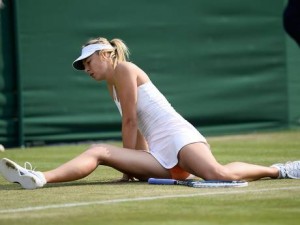

|
Back to Archive Index |
JUNE 30,2013 Did Wimbledon's Courts Wreck Players' Knees? The slippery grass courts at Wimbledon led to injuries of 7 top tennis players on Day 3 of the prestigious tournament last Wednesday. Four players injured their knees - Victoria Azarenka, John Isner, Marin Cilic, and Jo-Wilfried Tsonga. Prominent players, such as Maria Sharapova and Caroline Wozniacki, who both lost their matches, criticized the condition of the courts.  One of Maria Sharapova's spills at Wimbledon. One of Maria Sharapova's spills at Wimbledon.But it's more likely that the rigors of the game, rather than the courts, were to blame. No matter what the surface, knee injuries are quite common in tennis players because of the sharp side-to-side movements required. Azarenka, who withdrew, hurt her right knee on Monday when she slipped on Court One. Tsonga, Isner, and Cilic mostly blamed pre-existing physical problems or one-off injuries that were not caused specifically by slipping on the grass. Most of us never get a chance to play tennis on grass courts and so will never know how slick the courts can be. I once played on a grass court on vacation in Hawaii, and didn't find it particularly slippery, although the skidding ball made me bend me knees more than usual. Knee Cartilage Tears One of the most prevalent knee injuries among players in their 40s and 50s is a knee cartilage tear, particularly among those who play intensely. The basic problem is that the aging knee cartilage loses some of its water content and elasticity and, consequently, some internal strength. These changes make tears more likely. Tears occur when you land, anchor your foot, and then attempt an inward or outward pivoting motion. Most players experience some pain and may feel tearing within the knee, although some feel no tearing and have relatively little, if any pain. A swollen knee on the day following a painful episode is a good indication that you have damaged your knee. Medial cartilage tears, on the inside of the knee, are more common than lateral cartilage tears, on the outside of the knee. Many tennis players simply live with a cartilage tear that does not bother them too much. Even a highly active player, who is much more likely to have symptoms, may only feel intermittent pain. If you have a cartilage tear and it remains painful even after conservative treatment with anti-inflammatory agents, decreased activity, and quadriceps-strengthening exercises, then arthroscopic surgery can remove the torn portion of cartilage. Then you should rehabilitate your leg muscles to help regain full range of motion in the knee. Like most tennis players, if you have torn cartilage you can likely return to play at the same level, even if you need surgery more than once for tearing knee cartilage. |
|
|
|
Disclaimer and Copyright · Site design by Marketorial.com
|